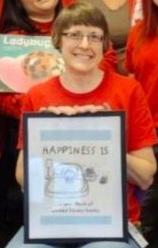Transforming a Recently Reopened Library with an Infusion of Culturally Relevant Books
- Log in to post comments

Background Basics
Hibbard Elementary School is in the diverse Albany Park Community of Chicago. Our poverty level is 88% and most of our students are English Learners. Nine years ago, our school librarian left for another district based on cuts to many Chicago Public School libraries. Our then-principal couldn’t afford to staff the position with an outside hire, so the space became a catch-all for after-school programs, testing, meetings, and storage. Seven years later, it was in shambles.
Rebirth and renewal
Statistically, students of color have less access to a school library. This compounds the barriers they face to achieve a better future in an information-heavy society. Post-COVID, I realized I needed to reignite my passion for teaching and learning. It became my goal to help students overcome achievement barriers in a new way. After over 25 years as a classroom teacher, I began the coursework to become a certified school librarian. A third of the way through my program, a new administrator arrived at Hibbard. She was very supportive of my proposal to reopen the library space. Many changes over these 7 years required attention: updating the collection to reflect our school and greater community demographics, curating resources to support new curriculum in core subject areas, updating our library technology, and teaching the students the concept and value of a library.
RAILS Resources
For decades, Albany Park has been a landing space for newcomers to the United States. Our school offers a dual-language Spanish program, and many recently arrived native Spanish speakers are placed at Hibbard. Students arrive with trauma, educational gaps, and uncertainty. This has led to difficulties in forming relationships, closing academic and social-emotional gaps, and transiency as families in shelters or other emergency housing secure more permanent living situations. I observed anti-immigrant sentiment not only from 2nd and 3rd generation students, but from students who had arrived as recently as 6 months earlier. The national sentiment did not help our situation. I designed an all-school anti-racism project from the lens of identity — cultural, religious, gender, and physical and emotional characteristics. Through nearly 300 new books, we explored traditions, countries, and fiction and memoirs about immigration, discrimination, and fighting for acceptance and understanding, both on individual and broader levels. We read about Jilly P., whose sister is born deaf, and Jilly learns about and advocates for resources that will shape her sister’s identity: using ASL, getting cochlear implants, etc. We read beautiful picture books about Ramadan and Eid, learned about cultural foods and celebrations, and listened to music of other cultures and countries. Students created a poster or slide about a book they read or a country they studied, focusing on those identity components. We focused on similarities rather than differences. I saw students flock to new books about countries: their own and others they wanted to learn about. We discussed stereotypes and bias, and how when people’s identity is different from ours, we can see that as a learning opportunity. We might change our thinking and even become an advocate for others. The books purchased through RAILS funding will be relevant for future students. Approximately 700 students experienced the project this year (our enrollment is about 922). Children who didn’t have library programming were still able to see student projects and read diverse books at a family literacy event held at the end of the project. Projects will also be displayed at our upcoming Cultural Celebration. Next year, I will continue to share culturally relevant and diverse books in a way that encompasses both students who did and did not experience the project this year. My ongoing goal is to create a ripple effect so we can increase tolerance and understanding while celebrating those identity components that make us who we are.
This week’s blog post was written by Sue Davidson, Librarian, Hibbard Elementary School.
This project was made possible by the My Library Is... Grant.
